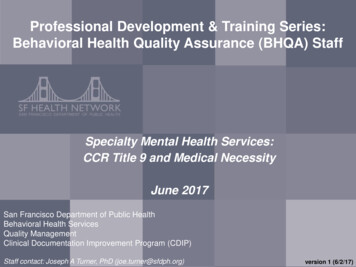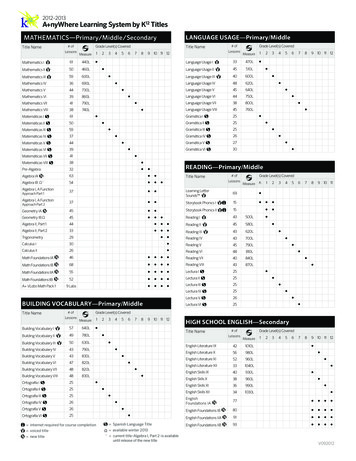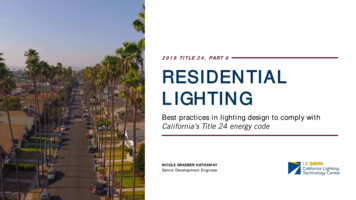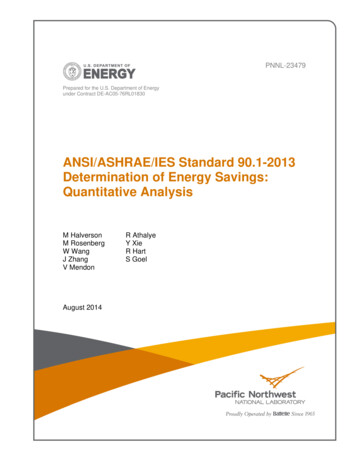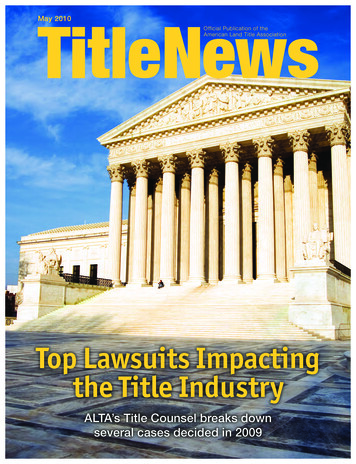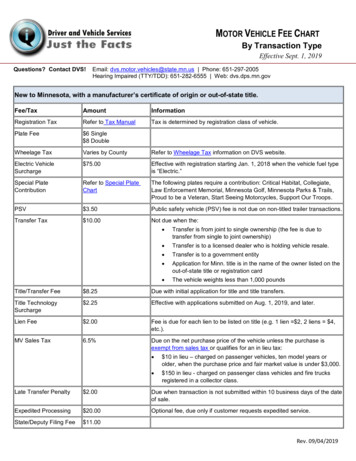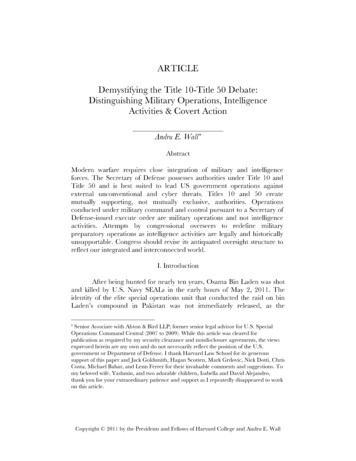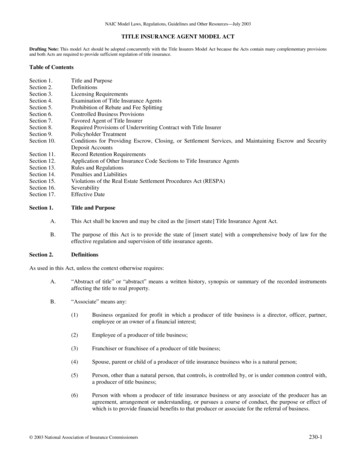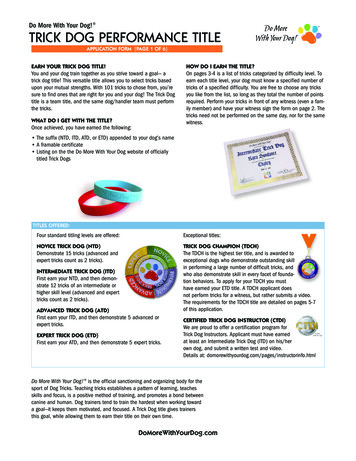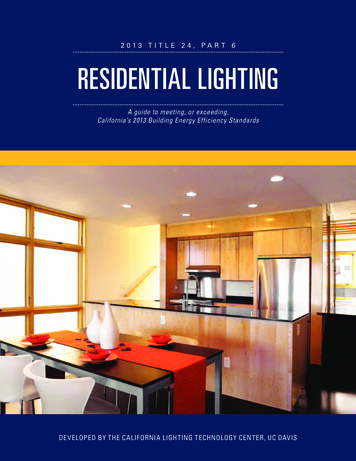
Transcription
2013 TITLE 24, PART 6RESIDENTIAL LIGHTINGA guide to meeting, or exceeding,California’s 2013 Building Energy Efficiency StandardsDEVELOPED BY THE CALIFORNIA LIGHTING TECHNOLOGY CENTER, UC DAVIS
2014, Regents of the University of California,Davis campus, California Lighting Technology CenterGuide Prepared by:California Lighting Technology Center (CLTC)University of California, Davis633 Pena DriveDavis, CA 95618cltc.ucdavis.eduProject Partners:California Energy CommissionPacific Gas and Electric CompanyThis guide is designed to help builders and lighting industry professionals become more familiar with theresidential lighting portion of California’s 2013 Building Energy Efficiency Standards (Title 24, Part 6).The guide provides information on current lighting technologies, lighting design terms and principles, andbest-practice recommendations. It is designed to complement lighting courses developed through CLTCand sponsored by Pacific Gas and Electric Company through its Energy Education program.
2 013 T IT L E 24, PA R T 6:RESIDEN TIA L L IGH TINGCONTENTS1 INTRODUCTIONThe Compliance Process.7Finding Compliant Products. 92 CONCEPTS & PRINCIPLESLayers of Light. 11Lumen Output, Efficacy & Life.12Color Characteristics.143 COMPLIANCE REQUIREMENTSNew in 2013: An Overview of Updates.17Efficacy Classification. 18Controls. 204 REQUIREMENTS &RECOMMENDATIONS BYSPACE TYPEKitchens. 26Bathrooms. 30Garages, Laundry Rooms & Utility Rooms. 32Other Rooms. 34Outdoor Lighting. 36Indoor Common Areas ofMultifamily Buildings. 38Outdoor Common Areas ofMultifamily Buildings. 395 APPENDIXGlossary. 41Resources. 46
42013 TITLE 24, PART 6
CHAPTER 1INTRODUCTIONTHE BENEFITS OF EFFICIENCYEconomic SavingsThe 2013 Title 24, Part 6 standards reduce energy use for lighting, heating,cooling, ventilation, and water heating by 25% compared to the 2008 Title 24,Part 6 standards. The California Energy Commission estimates theseimprovements will add 2,290 to the cost of constructing a new residentialbuilding, but they will reduce energy costs by an estimated 6,200 over30 years. In other words, the new efficiency standards will add approximately 11 per month to a 30-year mortgage for the average home, but they will save 27 per month in heating, cooling, and lighting expenses. Energy efficiencyimprovements also increase home values.Environmental BenefitsCalifornia is making strong efforts to address climate change. The state’sbuilding and appliance standards, along with utility programs that promoteefficiency, are vital means of reducing electricity use and lowering statewidecarbon emissions.California’s ambitious energy and climate goals include those legislated underthe Lighting Efficiency and Toxics Reduction Act (AB 1109). Passed in 2007,this bill calls for a 50 percent reduction in lighting energy use for interiorresidential lighting by 2018. California’s 2008 Long-Term Energy EfficiencyStrategic Plan also set the goal that all new residential construction in thestate be zero net energy (ZNE) by 2020.RESIDENTIAL LIGHTING GUIDE5
INTRODUCTIONABOUT THIS GUIDEThis guide is designed to help builders, lighting designers, contractors, and other end usersbecome more familiar with the lighting portion of California's 2013 Title 24, Part 6 residentiallighting standards. It is designed to serve as a resource for lighting industry professionalsinvolved in the construction, maintenance, or retrofit of California’s residential buildings. Theguide includes compliance requirements as well as recommendations for implementing thestandards in new construction or renovation projects.Compliance Process OverviewThe guide begins with an overview of the compliance process including theresponsibilities, requirements and documentation involved in each phase of aproject, from design to final inspection.Concepts & PrinciplesChapter 2 is devoted to lighting concepts and principles such as color rendering, colortemperature, light output, and lamp life. These concepts are vital for making informeddecisions regarding lamps, luminaires and controls.Compliance RequirementsStarting with an overview of new requirements and important updates to the 2008 standards,this portion of the guide examines the new Title 24, Part 6 requirements for luminaire efficacyclassification and lighting controls. Recommendations for putting the standards into practiceare also included.Requirements & RecommendationsThis section of the guide covers the lighting requirements set forth under Title 24, Part 6 forthe most common residential space types. Floor plans with examples of compliant lightingdesigns are also provided, along with recommendations for implementing best practices.NOTE: This guide is not intended to be used in lieu of California’s Title 24 Building Energy Efficiency Standards,and it is not a substitute for the code itself. Please visit www.energy.ca.gov / title24 to download theofficial 2013 Title 24 Building Energy Efficiency Standards, Errata, Reference Appendices, and theResidential Compliance Manual.62013 TITLE 24, PART 6
INTRODUCTIONTHE COMPLIANCE PROCESSThe following is an overview of the compliance process for residential lighting. Additional informationand resources, including the 2013 Nonresidential Compliance Manual and forms may be foundon the California Energy Commission website: s, energy consultants, designers, and other building professionals involved inthe design phase of a project must ensure that their projects are compliant with Title 24standards. They must also ensure that compliance measures are documented on thebuilding plans and specifications, and on any certificates of compliance. These forms mustbe submitted to the local enforcement agency (i.e., the city or county government office).Permit ApplicationAfter construction documents are ready and other approvals have been secured (from theplanning department, water authority, etc.), the owner or contractor then completes abuilding permit application. Along with the building permit application, a set of compliancedocuments must be submitted to the enforcement agency, including certificates ofcompliance, building plans, and specifications. An energy consultant who understands thecode and compliance methods often prepares this documentation. Ensuring all forms anddocuments are complete, clear and accurate helps to expedite the permit application process.Plan CheckAs part of their work, representatives from local enforcement agencies comparethe requirements specified on residential Certificate of Compliance forms (Form CF1R)with building plans and specifications. If information is incomplete or unclear, the plansexaminer may require a permit applicant to make corrections and resubmit the buildingpermit application.RESIDENTIAL LIGHTING GUIDE7
INTRODUCTIONBuilding Permit IssuanceUpon approval by the plans examiner, the enforcement agency may issue a building permit,allowing the contractor to begin work. Building permits may be issued in phases. Forexample, a permit for site preparation will be issued before a permit for building construction.ConstructionDuring the construction process, the general contractor or specialty subcontractorsare required to complete various Certificate(s) of Installation (Form CF2R) that listTitle 24 requirements. These forms also document the energy features and technologycomponents installed in the building.HERS RegistrationAll new homes, additions over 1,000 ft 2, and / or alterations to an existing home that hasHome Energy Rating System (HERS) measures included in the compliance packagewill need to be registered with a HERS provider. This registration process includes theResidential Lighting Installation Certificate: CF2R - LTG - 01 - E for single-family dwellings OR CF2R - LTG - 02 - E for multi-family dwellingsHERS measures must be verified in the field by a HERS rater during construction. Visit theCalifornia Energy Commission's website for a current list of approved HERS cyIn multifamily dwellings of three or more units, occupants may move in after theenforcement agency issues an occupancy permit. In the case of single-family dwellingsor duplexes, a signed final inspection document often serves as approval for occupancy.The builder is required to provide the homeowner or building owner with operation andmaintenance manuals. The owner is then responsible for maintaining the building’senergy-efficiency features.Operation and maintenance manuals can provide owners and occupants with valuableinformation about the lighting features in their homes. This is especially important as newLED luminaires and advanced controls become more commonplace. Understanding basicterminology and what can be expected from new lighting systems, in terms of lifetime,functionality, quality, and energy savings, can increase acceptance of new technologies.82013 TITLE 24, PART 6
INTRODUCTIONFINDING COMPLIANT PRODUCTSCertain devices must be certified to the Energy Commission as meeting California’sAppliance Efficiency Standards (Title 20 of the California Code of Regulations). Othersare regulated under the Building Energy Efficiency Standards (Title 24, Part 6).Certification to the Energy CommissionThe California Energy Commission maintains an appliance database that lists avariety of products that are certified as meeting Title 20 and Title 24 requirements.The following appliances must be certified under Title 20: Torchieres Metal-halide luminaires Portable luminaires Undercabinet luminaires Luminaires with GU-24 socket and base configurations and GU-24 adaptors Lighting controls and ballasts for residential recessed luminaires LED lighting systems classified as high efficacy for compliance purposesThe Energy Commission's Appliance Efficiency Database also lists certified lamps,ballasts, and lighting controls.ApplianceEfficiency Databaseappliances.energy.ca.govThis online database ofproducts certified to theEnergy Commission hasa Quick Search functionallowing users to search byproduct type, brand or model.Lighting specifiers who wish to work with a product not yet listed in the databasecan encourage the manufacturer or a pre-approved third-party certifier to submitappliance certification data to the Energy Commission.IC / AT Recessed Luminaires, ASTM E283 CertifiedUnder Title 24, Part 6, all luminaires recessed in ceilings (not just those ininsulated ceilings) must meet the following requirements: Listed for zero-clearance insulation contact (IC): Luminaires must beIC rated with a nationally recognized testing lab (such as UL) Certified airtight per ASTM E283 - 04 (2012): The product label mustspecify ASTM E283 certification, or documentation is required to indicatethe luminaire has been tested and certified in accordance with ASTM E283 Sealed airtight with a gasket or caulking: Any space between theluminaire housing and ceiling must be sealed during installation to preventairflow between conditioned and unconditioned spacesRecessed luminaires must also be certified to the Energy Commission for compliancewith any applicable ballast requirements in Section 150.0(k)8, and buildingoccupants must be able to readily access ballasts for maintenance or replacementwithout needing to cut holes in the ceilings. Fluorescent lamps rated 13 W or moremust have electronic ballasts with an output frequency no less than 20 kHz.Energy Star All Energy Star-certifiedluminaires and Energy StarLED lamps carry a warrantyof at least three years. TheVoluntary California QualityLED Lamp Specificationrequires that LED replacementlamps come with a minimumfive-year free replacementwarranty in order to qualifyfor utility rebates.For more information, see Section 150.0(k)8 and theResidential Compliance Manual, Chapter 6.1.2 – 3 and 6.3.12 – 13.RESIDENTIAL LIGHTING GUIDE9
102013 TITLE 24, PART 6
CHAPTER 2CONCEPTS & PRINCIPLESLAYERS OF LIGHTAdding task and accent lighting to ambient lighting allows ambient lighting loadsto be reduced without compromising safety or visual comfort. In fact, this layeredapproach to lighting improves visual comfort by reducing contrast. Lighting designsthat include task and accent lighting are also more attractive, as they provide varietyand visual interest.Ambient LightingAmbient lighting should provide a comfortable level of brightness withoutcausing glare. Most rooms benefit from having a central ambient light sourcein the form of a ceiling - mounted luminaire, recessed lights, wall-mountedluminaires, or a chandelier. In certain spaces, such as laundry rooms andclosets, ambient lighting may also serve as the primary source of task lighting.Task LightingTask light levels supplement ambient light levels and maximize efficiency byplacing light directly where it is needed and allowing occupants to switchit on only when it is needed. A table lamp, for example, provides extra lightfor reading. Undercabinet lighting in the kitchen makes cooking and foodpreparation safer and easier.Task lighting should be bright enough to prevent eye strain without causingglare. Multiple light sources can cast shadows that make tasks more difficult.High-quality task lighting makes visual tasks easier, and it allows for lowerambient light levels, reducing energy use.Accent LightingTrack lighting, cove lighting and wall-mounted luminaires are common choicesfor accent lighting. These luminaires can highlight architectural features,spotlight artwork, or illuminate interior design elements.PHOTO: LUTRONColor tunable LED products for the home are becoming more prevalent andmore affordable, offering new options for accent lighting. For instance,with the press of a button, occupants can temporarily wash their walls withcolored light. Recessed downlights provide ambient lightingin this kitchen while undercabinet and pendantluminaires deliver task lighting where it is needed.RESIDENTIAL LIGHTING GUIDE11
CONCEPTS & PRINCIPLESLUMEN OUTPUT, EFFICACY & LIFEMany consumers estimate the light output of lamps and luminaires based on the amount of powerthey draw, but it is lumens (lm), not watts (W), that indicate luminous output. More efficientsources can produce the same amount of light as legacy sources while consuming less energy.Luminous OutputThe amount of visible light emitted by a light source is measured in lumens (lm). The morelumens, the more light emitted, but other factors also affect visibility and perception ofbrightness, such as contrast ratios and color characteristics. In addition, the type of fixtureor housing can greatly affect the amount of lighting reaching its intended target.RecommendationsCompare the light output, not the energy consumption, of existingand replacement light sources or luminaires to ensure adequatelighting is maintained. Consider other factors, such as contrast, distribution and color quality;these also affect nighttime vision and perceived brightness. Install lighting controls, such as dimmers or motion sensors, to maximizeenergy savings while automatically tailoring light levels to occupants' needs. To avoid energy waste and excessive illumination, be sure to factor both task lightingand ambient lighting into the overall lighting design for a space.Comparing Lumens vs. WattsLUMENS4508001,100MORE EFFICIENTLESS EFFICIENTDIMMER1,600BRIGHTERStandardIncandescent40 W60 W75 W100 WHalogenIncandescent29 W43 W53 W72 WCFLs10 W13 W16 W20 WLEDs5W10 W15 W19 WSources: U.S. Department of Energy Building Technologies Office,“CALiPER Snapshot: Light Bulbs,” October 1, 2013.Natural Resources Defense Council, “Your Guide to More Efficient andMoney-Saving Light Bulbs,” October 30, 2013.122013 TITLE 24, PART 6
CONCEPTS & PRINCIPLESLuminous EfficacyIn lighting, the term efficacy refers to the ratio of luminous output produced by a lightsource to power consumed by that source (lm / W).Efficacy Lumens / Rated WattsDifferent source technologies provide different efficacy levels. For example, a75 W A19 incandescent lamp, a 16 W A19 CFL lamp, and a 15 W A19 LED lamp usedifferent amounts of power to produce the same amount of light (approximately1,100 lumens). Each type of lamp has a different rated efficacy, with the LEDexample being the most efficacious (producing the most lumens per watt).When assessing the overall value of lamps or luminaires, efficacy and initialproduct costs are two factors to consider. It is also important to compare longevity,lifetime performance and long-term energy and maintenance costs.LifeElectric light sources have the potential to fail due to several factors, includingfaulty electrical components, corrosion inside the lamp, or lumen depreciation(the gradual decrease in lumen output that occurs over time).Incandescent lamps typically last 1,000 – 2,000 hours and lose about 10 – 15% of theirinitial lumen output before burning out. A CFL lamp lasts about 12,000 hours andloses about 10 – 15% of its output before burning out. Linear fluorescent lampstypically last 25,000 – 40,000 hours, losing 5 – 10% of their original lumen outputbefore they fail.Lighting Facts LabelThe Lighting Facts Label helpsconsumers understand lampperformance and compareproducts. Information can alsobe found through manufacturers’websites and in productspecification sheets. A simplified,black and white version of thislabel is now required by theFederal Trade Commission forall general service, mediumscrew-base lamps.LEDs do not burn out suddenly in the same way as many legacy sources, theirlumen output continues to decrease very gradually over time. Many LED A19replacement lamps are rated to last 25,000 hours or more before they lose 30% oftheir initial light output, and recent testing indicates the diodes in these lamps maymaintain useful light output longer than previously predicted. Capacitors or othercomponents that provide power to the LED circuit are more likely to fail beforethe LEDs themselves reach their end of useful life. For these reasons, basing LEDproduct life on lumen depreciation (L70 or 70% of initial lumen output, for example)may not be the best way to measure the useful life of LED lamps and luminaires.LED life testing methodologies are still evolving as the technology improves.Meanwhile, a few best practices can help maximize the life of LED lighting: Always follow manufacturer installation instructions, including references tobase position for replacement lamps (e.g. base-up, base-down or horizontal) Pair LED lamps and luminaires with manufacturer recommended dimmersand other controls Observe manufacturers’ recommendations on operating temperature toprevent heat-related performance degradationWarrantiesManufacturers offer competitive warranties for lighting products. Energy Starrequires that luminaires and LED lamps carry a warranty of at least three years.LED replacement lamps must come with a minimum five-year free replacementwarranty in order to meet the Voluntary California Quality LED Lamp Specificationand qualify for utility rebates.Vision NeedsChange with AgeAs we age, our eyes requiremore light to see clearly. TheIlluminating Engineering Societyof North America (IES) setslowest average minimummaintained recommendationsfor light level (lux) requirementsbased on the needs ofoccupants under 25 years old.These illumination requirementsdoubled for those ages 26 – 65and by quadrupled for thoseover age 65.Adjustable lighting systemswith scene settings and easilyaccessible controls canaccommodate the needsof more occupants, across abroader age range and over time.NOTE: Life and lumen maintenance information presented here comes from the The LightingHandbook, Tenth Edition (sec. 7), published by the Illuminating Engineering Society (IES) in 2011.RESIDENTIAL LIGHTING GUIDE13
CONCEPTS & PRINCIPLESCOLOR CHARACTERISTICSColor Temperature (CCT)Correlated color temperature (CCT) indicates the warmth or coolness of the light emittedby a given source. CCT is measured on the Kelvin scale (K). Light sources with a low CCT(2,700 – 3,000 K) give off light that is warm in appearance. Sources with higher CCT values(4,000 – 6,500 K) provide light with a cooler color appearance.Selecting light sources with consistent CCTs helps maintain some consistency in theappearance of various light sources. Check the Lighting Facts label for information onCCT (or “light color”), as well as lumen output, power consumption (watts) and efficacy.2000 K2500 KWARM142013 TITLE 24, PART 63000 K3500 KNEUTRAL4000 K4500 K5000 K5500 KCOOL6000 K6500 K
CONCEPTS & PRINCIPLESColor Rendering (CRI)The color rendering index (CRI) is the current industry standard for measuringhow accurately a light source renders the colors of the objects it illuminates.The maximum CRI value is 100. Residential lighting should have a minimum CRI of 80;light sources with a CRI of 90 or higher provide even better color rendering.Specifying lamps and luminaires with similar color rendering properties helps ensurewall color, carpeting and other materials have a consistent appearance, especiallyin adjoining spaces. The full-color Lighting Facts label issued by the Departmentof Energy includes CRI, but the black-and-white Federal Trade Commission labeldoes not. Most manufacturers can supply information on CRI if it is not immediatelyavailable on product packaging or literature.LED replacement lampsmust now meet certainperformance criteria in orderto qualify for utility incentiveprograms and rebates inCalifornia. These include: Minimum color accuracy(CRI) of 90 R9 greater than 50 CCT of 2700 K or 3000 K Color consistency95 CRI, 3000 K CCTPHOTO: SORAA80 CRI, 3000 K CCTVoluntary CaliforniaQuality LED LampSpecificationComparing Color QualityThe LED MR16 lamps used for these photos both have a CCT of 3000 K and wereproduced by the same manufacturer. The difference is that the first-generationlamp on the left has a CRI of 80 while the lamp on the right has a CRI of 95.RESIDENTIAL LIGHTING GUIDE15
162013 TITLE 24, PART 6
CHAPTER 3COMPLIANCEREQUIREMENTSNEW IN 2013: AN OVERVIEW OF UPDATESThose familiar with the 2008 Title 24, Part 6 residential lighting standards willfind few changes to the requirements in the 2013 iteration. Below is an overviewof the most significant updates.LED Quality CriteriaQuality requirements for residential LED lightingJoint Appendix JA8 of the 2013 regulations sets new quality standards forLED luminaires installed in residences. To qualify as high efficacy underTitle 24, Part 6, LED lighting must be designed and manufactured forresidential use. Indoor lighting must also provide accurate color rendering(minimum CRI of 90) and a CCT of 2700K – 4000 K. Outdoor LED lighting musthave a CCT of 2700K – 5000 K. Decorative monochromatic LEDs are exempt.BathroomsAt least one high-efficacy luminaireThe 2008 standards grouped bathrooms with other room types and allowed allbathroom lighting to be low efficacy if controlled by a vacancy sensor. Lightingin bathrooms is now addressed separately, and at least one high-efficacyluminaire is required. The remaining installed luminaires may be low efficacyand controlled by a vacancy sensor or high efficacy (sensors optional).Garages, Laundry Rooms & Utility RoomsAll high-efficacy luminaires and vacancy sensorsAll luminaires in garages, laundry rooms, and utility spaces must now behigh efficacy AND controlled by vacancy sensors. The 2008 standardsallowed for all high-efficacy lighting without controls or low-efficacy lightingcontrolled by a vacancy sensor.Common Areas of Multifamily BuildingsSize criteria for residential vs. non-residential standardsPHOTO: CLTC, UC DAVISCommon areas in multifamily buildings include interior hallways, lobbies,fitness facilities, and laundry rooms. In low-rise multifamily residential buildings(up to three habitable stories high) where the interior common areas constitute20% or less of the building’s total floor area, interior lighting must be allhigh efficacy OR controlled by an occupancy sensor.In each building where common areas exceed 20% of the total floor area,the permanently installed lighting must now comply with the nonresidentialrequirements of the 2013 Title 24, Part 6 standards. This includes occupancysensor requirements in corridors and stairwells, with lighting power set todecrease at least 50% during vacant periods. Common areas in residentialbuildings with more than three habitable stories must also meet certainsections of the nonresidential standards.RESIDENTIAL LIGHTING GUIDE17
COMPLIANCE REQUIREMENTSEFFICACY CLASSIFICATIONTwo Strategies for ComplianceTitle 24, Part 6 offers several methods of reducing lighting energy use in homes. Two main strategies require:1. High-efficacy light sources, sometimes requiring controls2. Low-efficacy light sources paired with mandatory controlsSome spaces, like garages, laundry rooms and utility rooms, require both high-efficacy luminaires and vacancy sensors.The full criteria for classifying luminaires as either high or low efficacy are listed in Section 150.0(k)(Tables 150.0-A and 150.0-B). Certification requirements for LEDs are detailed in Joint Appendix JA8.The residential standards also set basic requirements for how these strategies must be applied in differentresidential spaces, e.g., kitchens, bathrooms, garages. These requirements are discussed later in the guide.High-Efficacy Sources & LuminairesThe following types of light sources and luminaires satisfy Title 24 high-efficacy requirements (Table 150.0-A):ApplianceEfficiency Databasewww.appliances.energy.ca.govResidential LED luminairescertified to the CaliforniaEnergy CommissionPin-based linear or compactfluorescent lamps withelectronic ballastsJoint Appendix JA8Section 130.0(c) 6; Section 150(k) 1DPulse-start metal halide lampsInduction lampsLuminaires rated for use with lamps that are notlisted in Table 150.0-A must meet the minimumluminaire efficacy requirements listed inTable 150.0-B to qualify as high efficacy.Lamps with a GU-24 baseSection 150.0(k) 1AHigh-pressure sodium lampsLuminairePower RatingMinimum Efficacy0– 5 W30 lm / WOver 5 W – 15 W45 lm / WOver 15 W – 40 W60 lm / WOver 40 W90 lm / WSummary of Table 150.0-B182013 TITLE 24, PART 6
COMPLIANCE REQUIREMENTSLow-Efficacy Sources & LuminairesThe following lamps and luminaires are classified as low efficacy forpurposes of Title 24 compliance:ApplianceEfficiency Databasewww.appliances.energy.ca.govLED luminaires not certifiedto the California EnergyCommissionLuminaires compatiblewith low-efficacy sources,including any luminairethat allows for conversionbetween high- and lowefficacy sources withoutchanging the luminaire’shousing or wiringScrew-base lamps orluminaires capable ofoperating any type ofincandescent lampAdaptors that allow the useof low-efficacy lamps infixtures intended to usehigh-efficacy lampsHigh-EfficacyLED LuminairesThe Appliance EfficiencyDatabase allows users tosearch for “High EfficacyLEDs for Title 24” within itsLighting Products category.These compliant luminairesand light engines meetthe requirements of JointAppendix JA8, including: Minimum CRI of 90for indoor LEDs CCT of 2700 – 4000 K(2700 – 5000 K foroutdoor luminaires) Integral LED luminaireor LED light engine GU-24 base sourcesHigh-Efficacy ResidentialLighting sidentiallighting-guideTrack lighting that allowsrelocation of luminaireswithout altering wiringSection 130.0(c) 7– 8Mercury vapor lampsThe High-Efficacy ResidentialLighting guide providesinformation about lightingproducts and key lightingprinciples and best practicerecommendations. The guideis designed to help buildersand lighting industryprofessionals working onzero-net energy (ZNE) andsustainable residential projects.RESIDENTIAL LIGHTING GUIDE19
COMPLIANCE REQUIREMENTSCONTROLSSection 150.0(k)2Lighting controls allow increased flexibility and control over the lighting systems in a home.The controls requirements of Title 24, Part 6 aim to maximize energy savings whileensuring occupants are comfortable.Many lighting controls must be certified to the Energy Commission before they can beinstalled in lighting projects. This certification verifies that a device has the minimumfunctionality required by the Title 20 Appliance Efficiency Regulations and meets allstate and federal standards for energy efficiency.SwitchesWhat's New in the 2013 4-2013-codeNew requirements for lightingcontrols constitute one of thebiggest changes to California’sBuilding Energy EfficiencyStandards. This brief guideoffers an overview of importantrequirements and major updatesto the Title 24, Part 6 lighting code. Switches (left to right):Lutron Claro, Lutron Skylark,WattStopper RD250PIR Dimming Multi-wayConvertible Occupancy SensorCompliance Requirements1. Separate switching: Permanently installed high-efficacy luminaires must beswitched separately from low-efficacy luminaires.2. Manual control: All installed luminaires must be switched with readilyaccessible manual ON / OFF controls.3. No bypassing: No controls may bypass dimmer or vacancy sensor functionsPermanentlyInstalled LuminairesPermanently installed luminairesare attached to t
Residential Compliance Manual. 6 2013 TITLE 24, PART 6 INTRODUCTION. THE COMPLIANCE PROCESS The following is an overview of the compliance process for residential lighting. Additional information . Residenti

